Abstract
The rapid growth of traffic load and volume has put forward higher requirements for road durability. To extend the service life of roads, this work investigated the feasibility of using polyolefin elastomers with a two-phase molecular structure to simultaneously improve the high and low-temperature performance of asphalt. The characteristics of the polyolefin modifier were evaluated by differential scanning calorimetry first. Following evaluation, the storage stability, workability, and rheological properties of modified polyolefin-modified asphalt were measured through softening point difference, rotary viscosity, dynamic shear rheometer, and bending beam rheometer. Additionally, the engineering performance of modified asphalt mixtures was also investigated through Marshall stability, wheel-tracking, and three points bending experiments. The results show that polyolefin has two glass transition points which facilitate the simultaneous improvement of the high and low-temperature properties of asphalt. Meanwhile, no concerns are found about the storage stability and workability of polyolefin-modified asphalt. Furthermore, the results of rheological properties indicate that polyolefin can significantly enhance the deformation resistance at high-temperature and cracking resistance at low-temperature of asphalt binders. While the fatigue performance of the polyolefin-modified asphalt is slightly reduced, the residual Marshall stability, dynamic stability, and ultimate tensile strain of the asphalt mixture containing 8% polyolefin are 1.05 times, 1.31 times, and 1.17 times those of the control sample, respectively. The results of infrared spectroscopy demonstrate that there is no chemical reaction between the polyolefin-modified and the virgin asphalt. The improvement of polyolefin on asphalt performance can be explained by the existence of both “rigid” and “flexible” structures in polyolefin.
1. Introduction
Transportation is a basic, leading, and strategic industry of the national economy. The favorable economic situation has prompted the rapid development of the highway industry in China since the beginning of the new century [1]. By the end of 2021, the total mileage of highways in China reached 5.28 million km, and the total mileage of high-grade highways exceeded 160,000 km [2]. Asphalt pavement has been extensively employed in high-grade highways due to its advantages, including comfortable driving, skid resistance, wear resistance, and easy maintenance [3,4]. However, asphalt materials are susceptible to aging due to long-term exposure to coupled environments such as light, heat, oxygen, and water during service, resulting in the deterioration of pavement performance [5,6]. Additionally, modern traffic with large flow, heavy load, and vehicle channelization has greatly shortened the lifespan of asphalt pavement [7,8,9]. To meet the increasing traffic demand, polymer-modified asphalt technology has been proposed and has become a productive method to enhance the durability of asphalt pavement [10,11].
Polymers commonly applied in asphalt modification include polyethylene (PE) [12,13], polypropylene (PP) [14], polyethylene terephthalate (PET) [15,16], polyurethane (PU) [17], styrene butadiene styrene (SBS) [18], etc. Plastic wastes made of PP and PE are common in daily life, and their application to asphalt modification has a significant cost advantage and economic benefits [19]. However, both PP and PE are non-polar polymers, which have poor compatibility with asphalt [20]. PET and PU as asphalt modifiers have been hot research topics in recent years. However, the anti-cracking properties of PET or PU-modified asphalt cannot always be guaranteed effectively [21]. Given the above issue, researchers began to explore polymer modifiers with both rigid and flexible structures in their molecular composition. The special two-phase molecular structure gives modifiers the ability to improve the high and low-temperature properties of asphalt concurrently [22]. SBS, as a typical block copolymer, is representative of this kind of polymer and has become one of the most mature asphalt modifiers in highway engineering [23].
However, Cao et al. found that SBS molecular structure contains unsaturated double bonds, which are easy to break and oxidize under the action of ultraviolet light and high temperature, leading to the deterioration of asphalt pavement performance [22,24,25]. Therefore, some researchers use montmorillonite with SBS to compound modified asphalt, which enhances the anti-aging ability of SBS-modified asphalt to some extent [26]. However, the results also revealed that the above inorganic material was not ideally compatible with asphalt. Meanwhile, the expensive cost makes it difficult to popularize this method on a large scale. Therefore, there is still room for asphalt modifiers to be improved. Polyolefin elastomer is a polymer material made of ethylene and octene by in situ polymerization with metallocene as the catalyst, which usually has the dual characteristics of plastic and rubber [27]. Polyolefin elastomers are very similar to SBS in terms of molecular structure. They can also strengthen the high and low-temperature behavior of asphalt simultaneously. In addition, polyolefin does not have unsaturated bonds and few tertiary carbon atoms, which makes their heat resistant oxygen aging and ultraviolet aging ability particularly outstanding [28].
Therefore, asphalt modifiers to cope with modern traffic still have more room for development. To face the research gap, the primary objective of the research is to further promote the development of high-performance asphalt pavement by investigating the performance and improvement mechanism of polyolefin elastomer-modified asphalt. For this goal, modified asphalt binders with different polyolefin contents were prepared by the melting blending method first. Next, the rheological properties of modified asphalt were studied, along with storage stability and workability. Additionally, the engineering performance of modified asphalt mixtures was also determined through Marshall stability, wheel-tracking, and three points bending experiments. In the end, the enhancement mechanism of polyolefin elastomers on asphalt properties was verified by infrared spectroscopy and differential scanning calorimetry. The finding of this work can provide a novel strategy for improving the durability of asphalt pavement.
2. Materials and Methods
2.1. Virgin Asphalt, Aggregate, and Polyolefin Elastomer
The virgin asphalt selected in this research is 70# petroleum asphalt. The performance parameters of virgin asphalt were measured based on JTG E20-2011 [29], and the values are listed in Table 1. The aggregate used for the asphalt mixture is basalt purchased from a stone factory in Jingshan City, Hubei Province, and its physical indexes are all in line with the application requirements. Polyolefin 8003 was purchased from Dow Chemical Company, Beijing, China. Its performance parameters were measured with reference to ASTM standards, and the values are displayed in Table 2. All parameters of raw materials were tested three times in parallel.

Table 1.
The basic parameters of virgin asphalt.

Table 2.
The performance parameters of polyolefin elastomer.
2.2. Sample Preparation
2.2.1. Modified Asphalt Binders
The polyolefin elastomer-modified asphalt binders were prepared by the melt blending method. The specific steps follow. First, the polyolefin elastomer was heated to 120 °C for 30 min to remove water first. Second, the polyolefins of 2%, 4%, 6%, and 8% of the asphalt mass were added into the molten virgin asphalt at 170 °C. After the polyolefin elastomers were completely immersed into the asphalt, the speed of the shear machine was set at 6000 r/min for continuous shear for 1 h to obtain polyolefin modified binders. The modified asphalt samples were named P-0, P-2, P-4, P-6, and P-8 according to the content of polyolefin elastomer.
2.2.2. Modified Asphalt Mixtures
The AC-13 polyolefin modified asphalt mixtures were prepared regarding the Marshall design method in this work. The gradation composition of AC-13 is listed in Table 3. The ratio of asphalt to aggregate was set at 4.5% according to the preliminary experiments. The modified asphalt mixtures are named AM-0, AM-2, AM-4, AM-6, and AM-8 according to the content of polyolefin.

Table 3.
Sieve passage rate of asphalt mixture.
2.3. Measurement and Characterization
The glass transition temperature of polyolefin elastomer was determined by differential scanning calorimetry (DSC). The heating rates and cooling rates were set to 10 °C/min. Nitrogen as protective gas was continuously swept at a rate of 50 mL/min. Two cycles were performed for each experiment: the first cycle was used to eliminate the thermal history of the sample; the result of the second cycle was used for analysis.
The storage stability of polymer modified asphalt should receive attention since it will directly affect the durability of asphalt pavement. Softening point difference (SPD) tests were performed in this work to evaluate the storage stability of polyolefin modified asphalt. Three repeated tests were carried out on each sample to ensure the reliability of the results.
The workability of polyolefin-modified asphalt with different dosages was characterized through rotary viscosity tests, which were carried out at five different temperatures including 120 °C, 135 °C, 150 °C, 165 °C and 180 °C. Three parallel experiments were conducted for each sample at each test temperature.
A dynamic shear rheometer was used to measure the rheological properties of the modified binders at high temperatures. The experimental temperature was set in the range of 46~70 °C with 6 °C intervals. The complex modulus and phase angle was determined through high-temperature scanning experiments using a plate with a diameter of 25 mm. In addition, the temperature of the fatigue performance test was set in the range of 16~34 °C with 3 °C as the interval. The diameter of the plate used was 8 mm. The angular frequency and strain values were set at 10 rad/s and 12%, respectively. Each sample was tested once because of the high reproducibility of DSR on rheological properties of asphalt.
The low-temperature behavior of modified binders with different polyolefin contents was determined by the bending beam rheometer (BBR) experiment. The test was carried out at −12 °C. In addition, three parallel experiments were conducted on each specimen to ensure experimental accuracy.
Residual Marshall stability (RMS) was employed to estimate the moisture stability of polyolefin-modified asphalt mixture; the wheel-tracking experiment was employed to evaluate the high-temperature stability of the asphalt mixture; and the three points bending experiment was performed to determine the anti-cracking of the asphalt mixture under cold conditions. The above experiments were performed according to JTG E20 (2011). Three replicate experiments were conducted for each sample to ensure the reliability of the results.
The functional group information of modified asphalt was tested by infrared spectroscopy to confirm whether chemical reactions occurred between polyolefin elastomer and virgin asphalt. The samples were prepared by the potassium bromide tableting method. The wave number scan range was set as 4000~400 cm−1. The baseline correction and peak identification were achieved through the OMMIC software. In addition, repeat experiments were performed on all samples.
2.4. Research Plan
The research plan of the work is summarized in Figure 1.
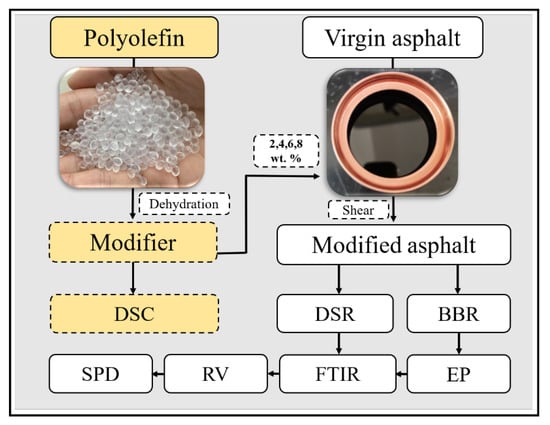
Figure 1.
Research plan of this work.
3. Results and Discussion
3.1. Characteristics of Polyolefin Elastomer
The glass transition temperature is the lowest temperature of polymer chain segment movement. The more flexible the molecular chain is, the lower the glass transition temperature is. The more rigid the molecular chain is, the higher the glass transition temperature is [35]. The DSC curve of polyolefin elastomer is shown in Figure 2.
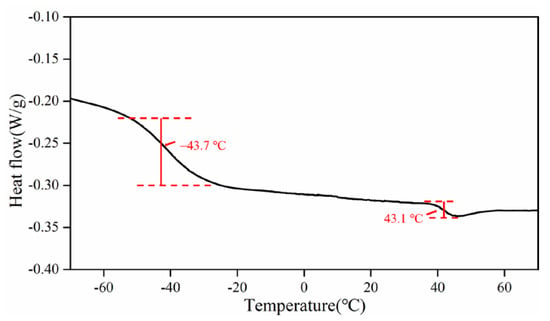
Figure 2.
DSC curve of polyolefin elastomers.
Two glass transition points can be observed from the DSC curve of polyolefin elastomer in Figure 2 according to the isometric method. This transition occurs because polyolefin is a copolymer of ethylene and octene and has the properties of both plastic and rubber. Figure 2 shows that the first glass transition temperature of polyolefin is around −43.7 °C, which can be attributed to the excellent flexibility of uncrystallized ethylene and octene segments in polyolefin at low temperatures, very similar to rubber. The second glass transition point of polyolefin elastomer is around 43.1 °C, which is related to the crystalline vinyl plastic segment in polyolefin. In conclusion, the presence of glass transition points was detected for polyolefins in both the high and low-temperature intervals, suggesting that polyolefin has the capacity to enhance the high-temperature and low-temperature performance of original asphalt concurrently.
3.2. Storage Stability
Qualified storage stability is the prerequisite for the successful application of modified asphalt, which also guarantees improving the durability of pavement. In general, the smaller the result of the softening point difference test, the better the storage stability of modified asphalt. It can be seen from Figure 3 that the softening point difference of modified asphalt gradually increases with the increase of polyolefin content. The softening point difference of modified asphalt is 0.2, 0.5, 0.7, 1.3, and 1.5 when polyolefin content is 2%, 4%, 6%, and 8%, respectively. In other words, the storage stability of polyolefin-modified asphalt prepared in this work meets the requirements of the industry (SPD < 2.5 °C) because polymer-based modifiers can generally be dissolved in molten asphalt to develop a stable state, especially at high shear rates and temperatures. Additionally, the density of the polyolefin modifier selected in this work is very close to that of base asphalt, which can prevent the settlement of the modifier in the asphalt. Furthermore, polyolefin elastomers catalyzed by metallocene are more polar than ordinary polyethylene or polypropylene, which also enhance compatibility with virgin asphalt. From the perspective of storage stability, it is feasible to use polyolefin as a modifier to improve asphalt quality and prolong the service life of asphalt pavement. However, the specific amount of polyolefin in asphalt needs to be further determined based on other experiments.
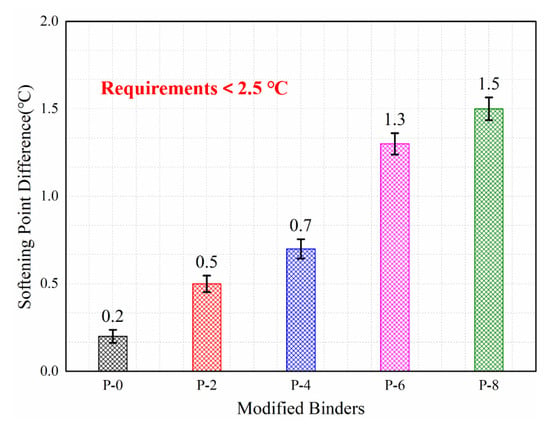
Figure 3.
Softening point difference of polyolefin-modified asphalt.
3.3. Workability of Modified Asphalt
The viscosity of asphalt modified with different polyolefin contents at different temperatures is shown in Figure 4. Three parallel experiments were conducted for each sample at each test temperature, and the experimental error was within acceptable limits. Figure 4 indicates that the viscosity of bitumen decreases significantly as the test temperature increases, which can be attributed to the fact that asphalt is typically a temperature-sensitive material. On the other hand, it can be found that the polyolefin elastomer can significantly increase the viscosity of asphalt at the same temperature. Specifically, the viscosity of modified bitumen with 2%, 4%, 6%, and 8% polyolefin is 1.17, 1.31, 1.66, and 1.93 times that of the base asphalt at 180 °C, respectively. This result can be explained by the melting of the polyolefin increasing the consistency of asphalt, which can prevent asphalt pavements from suffering from rutting during the hot season. In addition, to control the construction performance of the modified asphalt, the technical requirement that the viscosity of the modified asphalt shall not exceed 3 Pa.s at 135 °C is put forward in the SHRP asphalt binder performance specification. Figure 4 shows that, although the polyolefin content designed in this work increases the viscosity of asphalt, it does not damage the workability of asphalt. It is expected to continue to increase the content of polyolefin to improve the binding strength of modified asphalt without destroying other properties of asphalt.
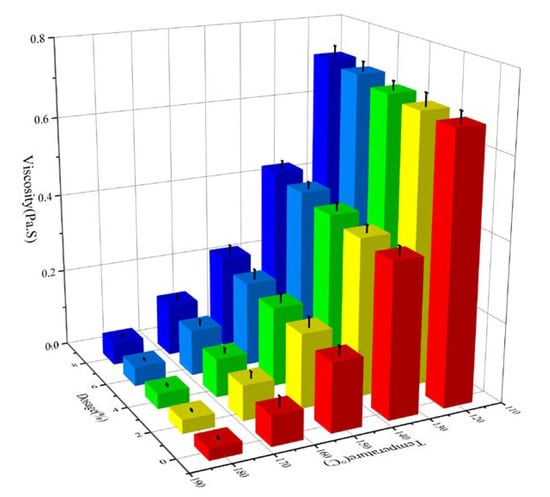
Figure 4.
Viscosity of polyolefin-modified asphalt.
3.4. Rheological Properties
3.4.1. Complex Modulus and Phase Angle
Asphalt as a typical viscoelastic material has both elastic and viscous characteristics, which can be represented by its complex modulus and phase angle. Asphalt with a higher complex modulus has a higher resistance to permanent deformation. Meanwhile, asphalts with higher phase angles are at less risk of fatigue cracking [36]. In this study, the complex modulus and phase angles of asphalt with different polyolefin contents at high temperatures are presented in Figure 5. Many previous studies have shown that DSR has strong repeatability in testing asphalt rheological indexes. Therefore, only one standard test was performed on each sample.
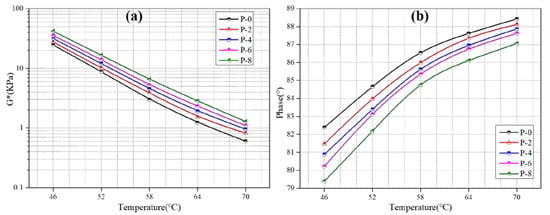
Figure 5.
Complex modulus (a) and phase angle (b) of modified binders.
Figure 5a indicates that the complex modulus of asphalt decreases sharply with increasing temperature, meaning that the high-temperature environment weakens the deformation resistance of asphalt. Consequently, asphalt roads are more prone to rutting in the summer. Correspondingly, Figure 5b illustrates that phase angle is positively related to ambient temperature, meaning that the asphalt gradually changes from elastic to viscous as the temperature rises. Therefore, asphalt pavement has less risk of fatigue cracking in the summer.
Additionally, Figure 5 shows that the introduction of polyolefin improves the complex modulus of asphalt but weakens the phase angle of asphalt. In other words, the resistance of the modified binders to permanent deformation is improved. For example, the complex modulus values of the modified binder with 8% polyolefin at 46 °C, 52 °C, 58 °C, 64 °C, and 70 °C are 17,400 Pa, 7739 Pa, 3539 Pa, 1613 Pa, and 685 Pa higher than that of the virgin asphalt, respectively. This difference may be caused by the crosslinking of polyolefin elastomers in virgin asphalt. In short, the introduction of polyolefin changes asphalt from viscous to elastic, which helps improve the asphalt’s resistance to deformation at high temperatures.
3.4.2. Rutting Factor
The rutting resistance of asphalt at high temperatures is usually evaluated by the rutting factor [37]. Generally, the greater the rutting factor is, the better the rutting resistance of asphalt is [38]. Figure 6 indicates that the rutting factor of all modified binders decreases with increasing temperature, suggesting the shift of asphalt from the rubbery to the viscous state. Additionally, all modified binders’ rutting coefficient increases with the increase of polyolefin dosage, suggesting that the resistance to rutting deformation of asphalt modified by polyolefin has been greatly improved. This change is caused by the hardening effect of the rigid structures of polyolefin molecular chain on virgin asphalt.
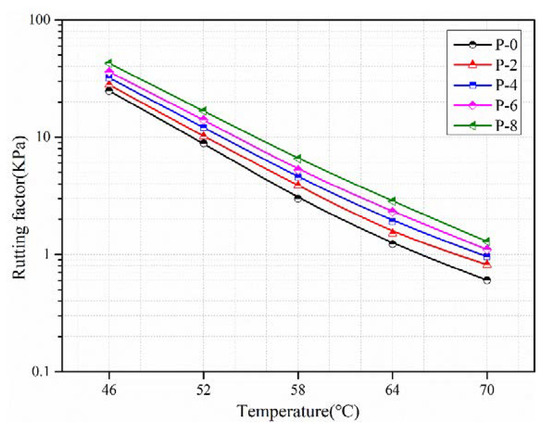
Figure 6.
The rutting factor of modified binders at high temperatures.
The rutting factor of asphalt should be not less than 1000 Pascal when grading by rutting critical temperature. The rutting factor values of all modified binders in this work at 64 °C and 70 °C are displayed in Table 4. Table 4 demonstrates that the rutting factor of all samples exceeds 1.0 kPa at 64 °C, but when the experimental temperature is 70 °C, only the rutting factors of P-6 and P-8 meet the requirement. This result confirms that the elastic properties of polyolefin can significantly strengthen the high-temperature behavior of asphalt. Nevertheless, the specific content of polyolefin in asphalt needs to be further determined based on fatigue and low-temperature properties.

Table 4.
Rutting factor of all modified asphalt at 64 °C and 70 °C.
3.4.3. Fatigue Factor
The fatigue factor is usually employed to characterize the fatigue cracking resistance of asphalt materials at intermediate temperatures. The smaller the fatigue factor of asphalt is, the stronger its anti-fatigue ability is [39]. Fatigue factors of all modified asphalt binders in this study are shown in Figure 7.
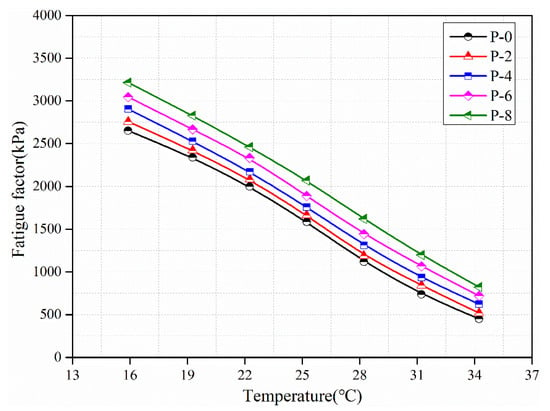
Figure 7.
Fatigue factor of modified binders at intermediate temperatures.
Figure 7 demonstrates that the fatigue factor of all specimens decreases with increasing temperature, indicating that the risk of fatigue cracking of asphalt pavement is smaller under high-temperature environments. However, it can be observed from the figure that, at the same temperature point, the fatigue factor of the polyolefin-modified binder is larger than that of virgin asphalt, suggesting that introducing polyolefin compromises the anti-fatigue ability of the asphalt to some degree. This compromise can be explained by the fact that the rigid chain in polyolefin improves the stiffness of virgin asphalt and damages the flexibility of asphalt, to a certain extent. Nevertheless, due to the existence of relatively flexible rubber chain segments in polyolefin, the influence of polyolefin elastomer on the fatigue property of asphalt is very weak at a low dosage. However, it also found that the fatigue factor of modified asphalt increases with the amount of polyolefin. Consequently, strict control the amount of polyolefin in asphalt is recommended to ensure that the modified asphalt has qualified fatigue resistance.
3.4.4. Creep Stiffness Modulus and Creep Rate
Brittle cracking is the dominant damage form of asphalt pavement in high latitude areas. As a result, it is of great practical value to enhance the low-temperature performance of asphalt pavement to reduce the maintenance frequency of roads in cold areas. In this study, the cracking resistance of all modified asphalt samples at low temperatures was measured through a bending beam rheometer. Two key parameters, namely creep stiffness modulus (S) and creep rate (m-value), were obtained by the experiment. In general, the smaller the S value is, the larger the m-value is, and the better the low-temperature cracking resistance of asphalt is [40]. Figure 8 indicates the experimental results of all modified asphalt binders at −12 °C. The errors of the parallel experiments for each sample were within reasonable limits. It can be observed from Figure 8 that under the same test temperature, the S value of polyolefin-modified asphalt is inferior to that of original asphalt, while the m-value of polyolefin-modified asphalt is greater than that of original asphalt. The S value and m-values of P-8 are 0.82 and 1.30 times those of virgin asphalt, respectively. This finding illustrates that polyolefin elastomer improves the low-temperature behavior of asphalt. The first glass transition point of polyolefin is around −43.7 °C according to the previous DSC experimental results, which means that the uncrystallized ethylene and octene in polyolefin are still in a soft rubber state under the BBR test temperature. The flexible polymer chain allows the asphalt to disperse impact energy when impacted, which reduces the chance of cracking. Consequently, polyolefin elastomer can extend the service life of asphalt pavement in cold areas, to a certain extent.
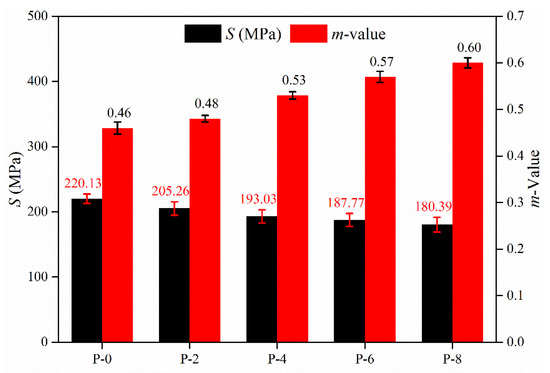
Figure 8.
Effect of polyolefin elastomers on the low-temperature behavior of asphalt.
3.5. Engineering Performance
The experimental results of the engineering behavior on asphalt mixture with different polyolefin dosages are listed in Table 5. Results show that the Marshall stability, residual Marshall stability, dynamic stability, and ultimate flexural strain of the asphalt mixture after adding polyolefin have significantly improved, suggesting that the addition of polyolefin can enhance the resistance to moisture damage, rutting deformation, and low-temperature cracking of asphalt mixture. These improvements can be explained by the fact that with the decrease of temperature after completion of construction, polyolefin will precipitate in the form of microcrystals, which will increase the stiffness of asphalt binder and further enhance the resistance of the asphalt mixture to high-temperature deformation and moisture damage. For low-temperature performance, the ultimate flexural strain of the asphalt mixture with polyolefin as a modifier was also observed to increase, indicating that the addition of polyolefin improved the flexibility of the asphalt mixture. This phenomenon is consistent with the results of the BBR test, which show asphalt profits from the uncrystallized flexible structures in the polyolefin molecular chain. The residual Marshall stability, dynamic stability, and ultimate tensile strain of the asphalt mixture containing 8% polyolefin are 1.05 times, 1.31 times, and 1.17 times those of the control samples, respectively.

Table 5.
Engineering performance of polyolefin modified asphalt.
3.6. Modification Mechanism
The experimental results of the infrared spectrum of all specimens in this study are displayed in Figure 9. All curves presented are reproducible. Seven obvious absorption peaks can be observed in the wave number interval from 400 cm−1 to 4000 cm−1. The characteristic peaks at 2921 cm−1 and 2851 cm−1 are induced by stretching vibration of −CH3 and −CH2 [41]. The absorption peak observed at 1600 cm−1 is caused by the vibration of the benzene ring C=C skeleton [42]. The absorption peaks at 1460 cm−1 and 1378 cm−1 are related to the bending vibration of −CH. The absorption peak at 1030 cm−1 is closely related to the S=O bond in asphalt [43]. The absorption band at 700~900 cm−1 of the fingerprint area is induced by the bending vibration of the C−H on the benzene ring. The characteristic peak of polyolefin-modified asphalt is almost the same as that of virgin asphalt, only the absorption peak intensity is slightly different. In addition, no fresh characteristic peaks can be observed from the infrared spectrum of polyolefin-modified asphalt. Therefore, it may be concluded that polyolefin elastomers do not affect the chemical properties of virgin asphalt, and mechanical blending is the main mode of interaction between them.
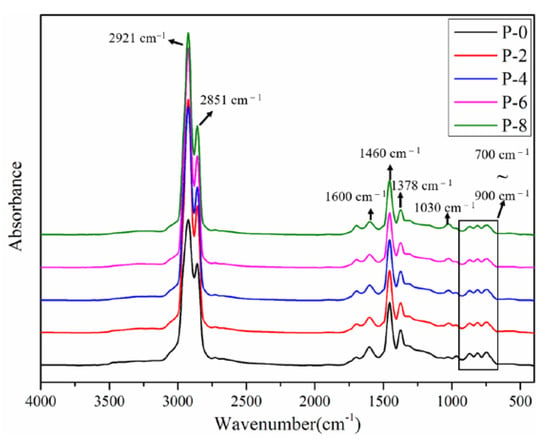
Figure 9.
Infrared spectra of polyolefin-modified binders.
In polyolefin, the crystallized ethylene segment (rigid structures) and the uncrystallized ethylene and octene (flexible structures) are two-phase structures, resulting in two glass transition points at −43.7 °C (Tg1) and 43.1 °C (Tg2), which has been verified in the DSC experiment. Meanwhile, asphalt was classified into three sections, namely brittle, flexible, and viscous states, using the brittle point (Tb~11.0 °C) and softening point (Ts~49.7 °C) as dividing points. To understand more clearly the enhancement mechanism of polyolefin elastomer on virgin asphalt, Tg1 and Tg2 of polyolefin elastomers are labeled on the temperature axis, as well as Tb and Ts of virgin asphalt in Figure 10. Since the Ts of virgin asphalt is close to the Tg2 of polyolefin, the above two temperature points are labeled at the same position in Figure 10.
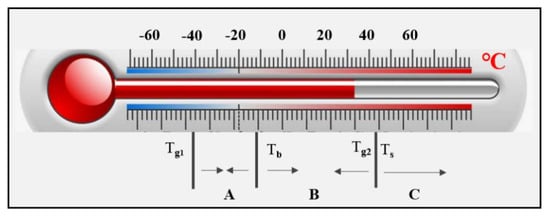
Figure 10.
Temperature axis of polyolefin-modified asphalt.
Virgin asphalt is brittle in interval A, while the “flexible structures” of polyolefins are flexible. Therefore, the brittleness of polyolefin-modified asphalt is reduced by the existence of the “flexible structures” which is responsible for the phenomena observed in the BBR and three points bending tests. In temperature interval B, the “flexible structures” of polyolefin and virgin asphalt are in the flexible state, while the “rigid structures” of polyolefin are in the glass state. The combined effect of the “flexible” and “rigid” structures may cause polyolefin-modified asphalt to be slightly hardened. Therefore, the complex modulus and rutting resistance of polyolefin-modified asphalt are improved within this interval, while the fatigue resistance is weakened. This improvement is consistent with the conclusions drawn from the above experiments. The virgin asphalt is mainly viscous in interval C. However, the “flexible” and “rigid” structures of polyolefin are still in a rubbery state. As a result, polyolefin-modified asphalt changes from viscous to elastic due to the “rigid structures” and “flexible structures.” In this temperature interval, the rutting resistance of polyolefin-modified asphalt will be enhanced. In summary, the mechanism of the enhancement of asphalt properties by polyolefin elastomers is displayed in Table 6.

Table 6.
Mechanism of the enhancement of asphalt properties by polyolefin.
4. Conclusions and Future Work
In this study, the feasibility of using polyolefin elastomers with a two-phase molecular structure to simultaneously improve the high and low-temperature performance of asphalt was investigated. Through the preceding analysis and discussion, the following findings can be obtained:
The polyolefin with a unique two-phase structure was detected by DSC to have a glass transition point (−43.7 °C and 43.1 °C) at high and low temperatures, respectively, which laid the foundation for improving the high and low-temperature properties of asphalt at the same time. In other words, it is reliable to select high-quality asphalt modifiers from the perspective of molecular structure to improve the durability of asphalt pavement.
The results of rheological properties demonstrate that polyolefin elastomer can significantly enhance the anti-deformation and anti-cracking abilities of asphalt binder, while the fatigue resistance of asphalt is weakened slightly by the hardening of polyolefin. In addition, no concerns are found about the storage stability and workability of polyolefin-modified asphalt. It is suggested that the exact dosage of polyolefin should be based on the premise that asphalt has sufficient anti-fatigue properties.
The engineering performance of the asphalt mixture indicates that the introduction of polyolefin can improve the moisture damage resistance, rutting deformation resistance, and cracking resistance of the asphalt mixture. The residual Marshall stability, dynamic stability, and ultimate tensile strain of the modified asphalt mixture are 1.05 times, 1.31 times, and 1.17 times of those of the contrast sample, respectively.
The infrared spectrum analysis of modified asphalt shows that asphalt modified by polyolefin is mainly mechanical blending. The improvement of polyolefin on asphalt performance can be explained by the existence of both “rigid” and “flexible” structures in polyolefin. It can be said that polymers with similar structures have the potential to simultaneously improve the high and low temperature performance of asphalt.
Overall, this work confirms that polyolefin elastomers have great potential as asphalt modifiers. However, there is a need for more extensive studies on field applications. Additionally, a deeper understanding of the aging resistance of polyolefin-modified asphalt and its adhesion to aggregates remains an outstanding research need in the future.
Author Contributions
Z.Y.: Writing original draft, Methodology, Conceptualization, Investigation. Y.Z.: Project administration, Resources, Supervision, Writing-review & editing. All authors have read and agreed to the published version of the manuscript.
Funding
This research received no external funding.
Institutional Review Board Statement
Not applicable.
Informed Consent Statement
Not applicable.
Data Availability Statement
Data will be made available on request.
Conflicts of Interest
The authors declare no conflict of interest.
References
- Li, H. Spatiotemporal Transportation Economics Development: Theories and Practices in China and Beyond; Springer Press: Berlin/Heidelberg, Germany, 2022; Available online: https://link.springer.com/book/10.1007/978-981-16-8197-4 (accessed on 15 April 2023).
- Statistics Bulletin of Transportation Industry Development in 2021. 2022. Available online: http://www.gov.cn/xinwen/2022-05/25/content_5692174.htm (accessed on 15 April 2023).
- Yang, C.; Wu, S.; Cui, P.; Amirkhanian, S.; Zhao, Z.; Wang, F.; Zhang, L.; Wei, M.; Zhou, X.; Xie, J. Performance characterization and enhancement mechanism of recycled asphalt mixtures involving high RAP content and steel slag. J. Clean. Prod. 2022, 336, 130484. [Google Scholar] [CrossRef]
- Zhao, Y.; Song, J.; Xie, J.; Wang, F.; Chen, M.; Wu, S.; Foong, L. Evaluation of the Volume Stability and Resource Benefit of Basic Oxygen Furnace Slag and Its Asphalt Mixture Based on Field Application. Adv. Civ. Eng. 2021, 2021, 6676154. [Google Scholar] [CrossRef]
- Zhao, Y.; Chen, M.; Wu, S.; Jiang, Q. Rheological properties and microscopic characteristics of rejuvenated asphalt using different components from waste cooking oil. J. Clean. Prod. 2022, 370, 133556. [Google Scholar] [CrossRef]
- Li, Y.; Feng, J.; Yang, F.; Wu, S.; Liu, Q.; Bai, T.; Liu, Z.; Li, C.; Gu, D.; Chen, A.; et al. Gradient aging behaviors of asphalt aged by ultraviolet lights with various intensities. Constr. Build. Mater. 2021, 295, 361–368. [Google Scholar] [CrossRef]
- Wei, H.; Zhang, H.; Li, J.; Zheng, J.; Ren, J. Effect of loading rate on failure characteristics of asphalt mixtures using acoustic emission technique. Constr. Build. Mater. 2023, 364, 129835. [Google Scholar] [CrossRef]
- Nettis, A.; Massimi, V.; Nutricato, R.; Nitti, D.; Samarelli, S.; Uva, G. Satellite-based interferometry for monitoring structural deformations of bridge portfolios. Autom. Constr. 2023, 147, 104707. [Google Scholar] [CrossRef]
- Ghyabi, M.; Timber, L.; Jahangiri, G.; Lattanzi, D.; Shenton, H., III; Chajes, M.M.H. Head, Vision-Based Measurements to Quantify Bridge Deformations. J. Bridge Eng. 2023, 28, 5022010. [Google Scholar] [CrossRef]
- Polacco, G.; Filippi, S.; Merusi, F.; Stastna, G. A review of the fundamentals of polymer-modified asphalts: Asphalt/polymer interactions and principles of compatibility. Adv. Colloid Interface Sci. 2015, 224, 72–112. [Google Scholar] [CrossRef]
- Zhu, J.; Birgisson, B.; Kringos, N. Polymer modification of bitumen: Advances and challenges. Eur. Polym. J. 2014, 54, 18–38. [Google Scholar] [CrossRef]
- Liang, M.; Xin, X.; Fan, W.; Zhang, J.; Jiang, H.; Yao, Z. Comparison of rheological properties and compatibility of asphalt modified with various polyethylene. Int. J. Pavement Eng. 2019, 22, 11–20. [Google Scholar] [CrossRef]
- Alghrafy, Y.; Alla, E.-S.A.; El-Badawy, S. Rheological properties and aging performance of sulfur extended asphalt modified with recycled polyethylene waste. Constr. Build. Mater. 2021, 273, 121771. [Google Scholar] [CrossRef]
- Nien, Y.-H.; Yeh, P.-H.; Chen, W.-C.; Liu, W.-T.; Chen, J.-H. Investigation of flow properties of asphalt binders containing polymer modifiers. Polym. Compos. 2008, 29, 518–524. [Google Scholar] [CrossRef]
- Leng, Z.; Padhan, R.; Sreeram, A. Value-added application of waste PET based additives in bituminous mixtures containing high percentage of reclaimed asphalt pavement (RAP). J. Clean. Prod. 2018, 196, 615–625. [Google Scholar] [CrossRef]
- Leng, Z.; Padhan, R.; Sreeram, A. Production of a sustainable paving material through chemical recycling of waste PET into crumb rubber modified asphalt. J. Clean. Prod. 2018, 180, 682–688. [Google Scholar] [CrossRef]
- Cong, L.; Yang, F.; Guo, G.; Ren, M.; Shi, J.; Tan, L. The use of polyurethane for asphalt pavement engineering applications: A state-of-the-art review. Constr. Build. Mater. 2019, 225, 1012–1025. [Google Scholar] [CrossRef]
- Yidirim, Y. Polymer modified asphalt binders. Constr. Build. Mater. 2007, 21, 66–72. [Google Scholar] [CrossRef]
- Nizamuddin, S.; Baloch, H.; Jamal, M.; Madapusi, S.; Giustozzi, F. Performance of waste plastic bio-oil as a rejuvenator for asphalt binder. Sci Total Environ. 2022, 828, 154489. [Google Scholar] [CrossRef]
- Behnood, A.; Gharehveran, M. Morphology, rheology, and physical properties of polymer-modified asphalt binders. Eur. Polym. J. 2019, 112, 766–791. [Google Scholar] [CrossRef]
- Sun, M.; Zheng, M.; Qu, G.; Yuan, K.; Bi, Y.; Wang, J. Performance of polyurethane modified asphalt and its mixtures. Constr. Build. Mater. 2018, 191, 386–397. [Google Scholar] [CrossRef]
- Yang, X.; Zhang, H.; Zheng, W.; Chen, Z.; Shi, C. A Novel Rejuvenating Method for Structural and Performance Recovery of Aged SBS-Modified Bitumen. ACS Sustain. Chem. Eng. 2022, 10, 1565–1577. [Google Scholar] [CrossRef]
- Han, X.; Mao, S.; Xu, S.; Yu, J.; Cao, Z.; Wang, R.; He, P.; Zeng, S. Effects of Reactive Chain Extension Rejuvenation Systems on the Viscosity–Temperature Characteristics, Rheological Properties, and Morphology of Aged Styrene–Butadiene–Styrene-Modified Bitumen. ACS Sustain. Chem. Eng. 2021, 9, 16474–16484. [Google Scholar] [CrossRef]
- Cao, Z.; Chen, M.; Yu, J.; Han, X. Preparation and characterization of active rejuvenated SBS modified bitumen for the sustainable development of high-grade asphalt pavement. J. Clean. Prod. 2020, 273, 123012. [Google Scholar] [CrossRef]
- Cao, Z.; Huang, X.; Yu, J.; Han, X.; Wang, R.; Li, Y. Study on all-components regeneration of ultraviolet aged SBS modified asphalt for high-performance recycling. J. Clean. Prod. 2020, 276, 123376. [Google Scholar] [CrossRef]
- Mao, S.; He, Y.; Liu, M.; Cao, Z.; Duan, H.; Yu, J. Effect of organic montmorillonite on properties of SBS modified asphalt. J. Wuhan Univ. Technol. 2022, 44, 6–11. [Google Scholar] [CrossRef]
- Sun, M.; Xiao, Y.; Liu, K.; Yang, X.; Liu, P.; Jie, S.; Hu, J.; Shi, S.; Wang, Q.; Lim, K.; et al. Synthesis and characterization of polyolefin thermoplastic elastomers: A review. Can. J. Chem. Eng. 2023, 22, 54–63. [Google Scholar] [CrossRef]
- Mahmood, Q.; Sun, W.-H. N, N-chelated nickel catalysts for highly branched polyolefin elastomers: A survey. R. Soc. Open Sci. 2018, 5, 180367. [Google Scholar] [CrossRef]
- JTG-E20; Standard Test Methods of Bitumen and Bituminous Mixtures for Highway Engineering. Highway Science Research Institute of the Ministry of Transport: Beijing, China, 2011.
- ASTM D1238-04; Standard Test Method for Melt Flow Rates of Thermoplastics by Extrusion Plastometer. US-ASTM: West Conshohocken, PA, USA, 2004.
- ASTM D638-14; Standard Test Method for Tensile Properties of Plastics. US-ASTM: West Conshohocken, PA, USA, 2014.
- ASTM D6272-17; Standard Test Method for Flexural Properties of Unreinforced and Reinforced Plastics and Electrical Insulating Materials by Four-Point Bending. US-ASTM: West Conshohocken, PA, USA, 2017.
- ASTM D2240-03; Standard Test Method for Rubber Property-Durometer Hardness. US-ASTM: West Conshohocken, PA, USA, 2003.
- ASTM D792-00; Standard Test Method for Density and Specific Gravity (Relative Density) of Plastics by Displacement. US-ASTM: West Conshohocken, PA, USA, 2000.
- Cerrada, M.; Benavente, R.; Perez, E.; Moniz-Santos, J.; Ribeiro, M. Experimental evidence of the glass transition in a metallocene ethylene-1-octene copolymer and its composites with glass fibre. Polymer 2001, 42, 7197–7202. [Google Scholar] [CrossRef]
- Zhao, Y.; Chen, M.; Wu, S.; Jiang, Q.; Xu, H.; Zhao, Z.; Lv, Y. Effects of waterborne polyurethane on storage stability, rheological properties, and VOCs emission of crumb rubber modified asphalt. J. Clean. Prod. 2022, 340, 130682. [Google Scholar] [CrossRef]
- Lv, S.; Hu, L.; Xia, C.; Peng, X.; Cabrera, M.; Guo, S.; You, L. Surface-treated fish scale powder with silane coupling agent in asphalt for performance improvement: Conventional properties, rheology, and morphology. J. Clean. Prod. 2021, 311, 127772. [Google Scholar] [CrossRef]
- Cao, Z.; Chen, M.; Liu, Z.; He, B.; Yu, J.; Xue, L. Effect of different rejuvenators on the rheological properties of aged SBS modified bitumen in long term aging. Constr. Build. Mater. 2019, 215, 709–717. [Google Scholar] [CrossRef]
- Zhao, Z.; Wu, S.; Liu, Q.; Xie, J.; Yang, C.; Wan, P.; Guo, S.; Ma, W. Characteristics of calcareous sand filler and its influence on physical and rheological properties of asphalt mastic. Constr. Build. Mater. 2021, 301, 3014–3019. [Google Scholar] [CrossRef]
- Zhang, H.; Chen, Z.; Xu, G.; Shi, C. Evaluation of aging behaviors of asphalt binders through different rheological indices. Fuel 2018, 221, 78–88. [Google Scholar] [CrossRef]
- Lv, S.; Xia, C.; Yang, Q.; Guo, S.; You, L.; Guo, Y.; Zheng, J. Improvements on high-temperature stability, rheology, and stiffness of asphalt binder modified with waste crayfish shell powder. J. Clean. Prod. 2020, 264, 121745. [Google Scholar] [CrossRef]
- Zhao, Y.; Gong, X.; Liu, Q. Research on rheological properties and modification mechanism of waterborne polyurethane modified bitumen. Constr. Build. Mater. 2023, 371, 130775. [Google Scholar] [CrossRef]
- Zhao, Y.; Chen, M.; Zhang, X.; Wu, S.; Zhou, X.; Jiang, Q. Effect of chemical component characteristics of waste cooking oil on physicochemical properties of aging asphalt. Constr. Build. Mater. 2022, 344, 128236. [Google Scholar] [CrossRef]
Disclaimer/Publisher’s Note: The statements, opinions and data contained in all publications are solely those of the individual author(s) and contributor(s) and not of MDPI and/or the editor(s). MDPI and/or the editor(s) disclaim responsibility for any injury to people or property resulting from any ideas, methods, instructions or products referred to in the content. |
© 2023 by the authors. Licensee MDPI, Basel, Switzerland. This article is an open access article distributed under the terms and conditions of the Creative Commons Attribution (CC BY) license (https://creativecommons.org/licenses/by/4.0/).